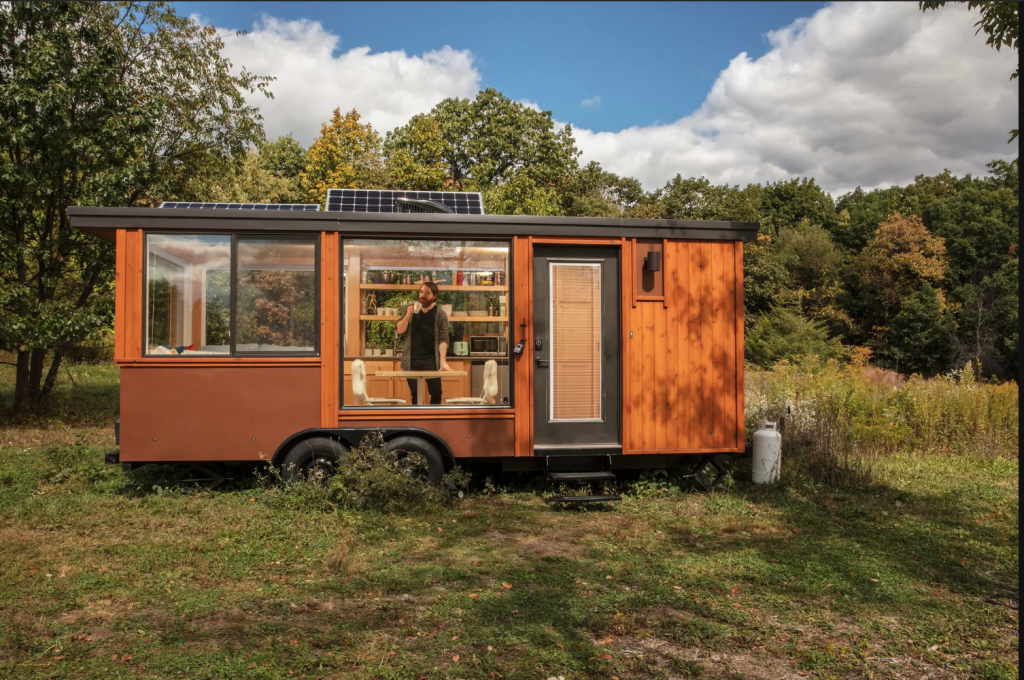
Tiny homes have become an international trend over the past ten years. A tiny home is commonly capped at a living space that is 500,000 square feet or less. Often these homes are built on wheels so that they can be moved easily. The small living fad has idealized a minimalist life-style and come to signal environmental mindfulness. Tiny homes reject the traditional American view of what a home should consist of in rejection of consumerism culture. Some fans of the movement link this housing choice all the way back to Thoreau’s cabin at Walden Pond and to a spirit of independence.
While the minimal environmental impact and respect for space are in fact good for the long terms success of cities and towns, many local governments have enforced zoning laws that make this type of living illegal. The New York metro area, like most densely populated regions, does not allow for long-term parking and living in RVs or other temporary living structures. Often zoning laws requirement minimum lot sizes or building structures that exceed the bounds of tiny homes. These zoning restrictions make it very difficult to find locations to park these structures. An estimated 90% of all tiny home users are living illegally either on public land or in the backyards/property of their friends and family.
There seems to be a disconnect between the rise in tiny home building companies to match the demand for small-scale living options and support from local municipalities. Current zoning regulations do have not kept up with the changing definition of “home.” The stagnant laws over prioritize the desires of those who can afford to live in large, permanently plotted homes. The tiny home movement started largely in response to the 2008 financial crash as a way for individuals who needed both greater locational and financial flexibility to still have claim to a place that is there. Failure to accept the changing definition of home encourages families and communities to continue to invest in the building culture that has promoted over-consumption and inefficient use of public resources.
I am not sure if tiny homes are the solution to sprawl or other unpleasant consequences of the current system of American zoning, but updating municipal practices to accept that this trend may actually benefit the greater community would be a meaningful first step.
Source: https://www.nytimes.com/2017/10/06/realestate/where-can-you-park-a-tiny-home.html

Thank you for bringing the matter of tiny homes to attention. I found your discussion on the independence they offer their owners especially salient. I believe it underscores a greater truth about the economic and environmental realities of home ownership. The house as an asset has long been the mainstream view. However, as the housing crisis brought to light, large homes are in many ways substantial liabilities. In a strict business sense, they are liabilities because they take money out of their owner’s pockets. They fester an economic dependence that leaves people vulnerable to market shifts and diverts financial resources away from other endeavors. When looking at the issue through an environmentally conscious lens, we see houses as strains on the landscape. It seems that unfavorable municipal laws are contributing to both unsustainable economic and environmental practices. If we offer individuals greater choice in their living opportunities, perhaps we can help foster greater financial and ecological responsibility.
Thank you for your insightful and informative post, Samantha!
I think you brought up a very interesting point about the distance between the demand for the tiny homes and the government’s pushback to them through zoning.
I understand why it is very difficult for the government to figure out how to classify these homes, especially if they are on wheels and can move very easily. Another question I have is how different are these Tiny Homes than a small studio apartment in a major metropolitan area?
I think that the government needs to figure out how to better accommodate Tiny Homes. One potential idea would be to create plots of land that are dedicated to Tiny Homes. This would allow for Tiny Homeowners to have a community with fellow Tiny Homeowners. This would be a similar solution to how moble homes work (I believe).
Very interesting material! Thanks!
Sam,
This was a fascinating read– thanks for sharing! As an avid viewer of HGTV’s “Tiny House Hunters” I think the concept is fascinating. One thing I think is particularly interesting about the rising trend in Tiny Homes is how they act as a substitute for traditional housing in the most expensive housing markets. Of course, for some, a tiny home is appealing because of the minimalist lifestyle and mobility that it can provide. But for many, especially in America’s most expensive markets, they are turning to non-traditional housing to avoid homelessness.
In places like San Francisco, where housing is so astronomically expensive, many have turned to living in vans or “tiny homes” to afford living in the area. As much as I admire the ingenuity of tiny homes, I wonder if our celebration of this trend is masking the underlying affordability crisis that has forced so many people to adopt this tiny home lifestyle. It seems to me that changing our legal definition of homes to incorporate these tiny homes into city living may be conceding that nothing can be done about this crisis. Rather than changing our definition of housing and pushing people to move into repurposed vans, shouldn’t we focus our attention on providing affordable housing?
Rebecca Werrell, who took this course last year, wrote a great paper on tiny houses. The role of zoning laws in restricting tiny houses demonstrates how oppressive and asinine zoning laws can be. Here’s a good video on the benefits and drawbacks of tiny houses: https://tinyhousegiantjourney.com/2018/07/02/tiny-house-cons/